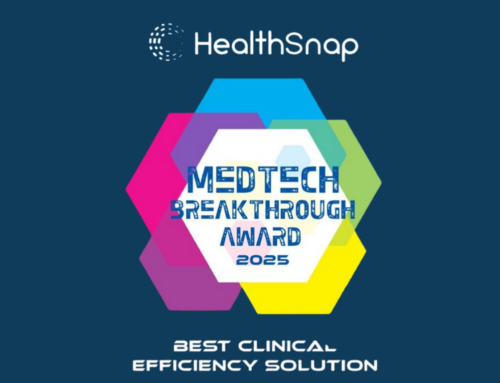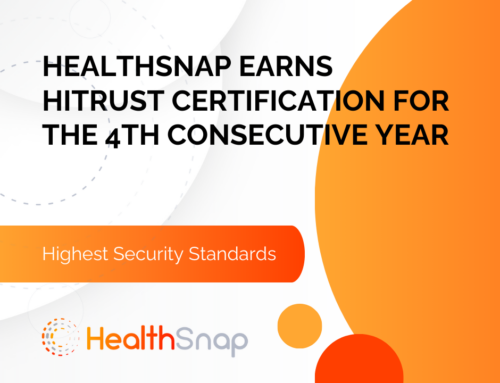With the advent of video chat and the ubiquity of internet-enabled devices and smartphones, telemedicine has acquired a radical new dimension in the last decade. Patients no longer need to rely on frequent in-person hospital visits to manage their chronic conditions, and healthcare professionals are more empowered to deliver superior patient care with reduced pressure on the health system.
As the technology continues to evolve, healthcare professionals now have access to two different forms of telemedicine deployments – synchronous and asynchronous programming systems. How are they different from each other? Which one is ideal for your telehealth goals? These are some of the questions we will answer in this guide, as we explore all major aspects of both these forms of telemedicine.
What is Synchronous Programming?
The hallmark of synchronous programming in telemedicine is live and interactive communications, held in real time between the patient and the healthcare provider. The short and succinct definition by the American Telemedicine Association, the major industry body, says it all: “Interactive video connections that transmit information in both directions during the same time period.”
For a more detailed explanation of synchronous tasks, we can also rely on the US Department of Veteran Affairs (VA). Here is how the VA defines synchronous telemedicine: “Synchronous telemedicine requires the presence of both parties at the same time and a communication link between them that allows a real-time interaction to take place.”
In more simplistic terms, synchronous telemedicine is the healthcare equivalent of a Zoom call or a FaceTime call. It is a live call and you need both parties to be present at the same time for a real-time exchange of information and interaction.
What is Asynchronous Programming?
In asynchronous operations, any live interaction between the patient and the healthcare specialist is conspicuously absent. There is a gap between the collection of data from the patient and its transmission to the health practitioner.
Once again, we can go to the American Telemedicine Association for a precise definition of asynchronous tasks in telemedicine. The definition is a bit longer than the one for synchronous telemedicine:
“Term describing the store-and-forward transmission of medical images and/or data because the data transfer takes place over a period of time, and typically in separate time frames. The transmission typically does not take place simultaneously.”
The VA’s take on this form of telehealth technologies goes something like this: “Asynchronous telemedicine involves acquiring medical data, then transmitting this data to a doctor or medical specialist at a convenient time for assessment offline.”
Instead of a live video call, we can look at asynchronous programs as the healthcare equivalent of email or a photo shared via file hosting services like Dropbox. You first capture the relevant data from the patient, store it digitally for a short time, and later transfer the data to a concerned healthcare professional.
Asynchronous programming is useful when a primary physician wants to send patient data to a specialist for a more accurate diagnosis. The specialist can review the data and make a diagnosis and provide any relevant treatment plans or suggestions via the same channel to the referring provider.
In general, asynchronous programming systems rely on secure web servers, encrypted emails, and other specially designed software for the sharing of electronic health records (EHR) between healthcare professionals.
Benefits of Synchronous Programming
In healthcare, speed, and efficiency are often major contributors toward more effective treatments and better patient outcomes. A near-instant access to their doctor’s advice makes the experience less stressful and more confidence-inspiring, from a patient’s perspective.
Synchronous programming brings the patient and healthcare provider together online, resulting in a smooth and accurate flow of information between both parties. There is less risk of vital minor details being missed out – doctors can ask for such details immediately since synchronous tasks happen in real time.
This empowers healthcare professionals to make better, more informed decisions regarding diagnosis and treatment plans. In many instances, the patient may benefit from immediate advice from their provider.
An article in mHealth Intelligence highlights the positive impact synchronous programming can have on the concept of an ongoing doctor-patient relationship. “Real-time telehealth provides timely care, especially in emergencies or urgent situations,” notes the article.
It’s not just the patients who receive the benefits of synchronous programming. Healthcare practices can also gain a significant advantage from adopting this technology. According to the American Journal of Emergency Medicine, “Synchronous audio-video telemedicine consults resulted in short-term cost savings by diverting patients from more expensive care settings.”
More importantly, the quality of care provided by synchronous operations is largely comparable to similar consultations carried out in person at a doctor’s office or private clinic. According to a review by the American Psychiatric Association, there was “no statistical difference in clinical outcomes for pharmacotherapy or psychotherapy delivered by synchronous video-conferencing treatment and in-person treatment.”
The manifold benefits of synchronous programming can be divided into two main categories – those that relate to patients and those that are related to the healthcare service providers.
Patient Benefits
We can list at least three major benefits to patients who suffer from chronic and lifestyle diseases when they join a care program that uses synchronous programming:
Access to Real-time Care
Emergency rooms across the nation are crowded with patients, many of them in critical condition. Due to triage policies, patients who have immediate life-threatening conditions get priority over others who have a less-severe emergency.
Many patients end up spending hours waiting for a chance to meet a doctor. With real-time care through synchronous programming, this can be avoided altogether. A patient in a medical emergency can call a primary care physician and get a quick diagnosis through a video call.
The doctor can visually identify any danger signs and ask the relevant questions over video chat. If the patient needs medication or even a quick trip to the ER, the doctor can provide the relevant advice in a timely manner.
Foster a Strong Patient-Provider Relationship
There are many minor health issues where getting some advice from your regular doctor can make a massive impact in the long run. With that said, making constant visits to the doctor’s office for such small issues can seem like overkill. Many patients end up ignoring the small warning signs due to this.
But with the option of synchronous care, patients have a relatively convenient way to connect with their doctors from the comfort of their homes. Over time, regular communication helps build trust between the patient and the healthcare provider.
Spot Warning Signs Early
Chronic diseases like diabetes often develop after a prolonged period of warning signs and early symptoms. With advance warning, preventive care, and lifestyle changes, patients can avoid the disease altogether or mitigate the damage done to the major systems.
A family physician or personal doctor can often spot the warning signs of chronic diseases much earlier than a new doctor at a hospital. Patients are also more likely, to be honest with their regular providers, which helps in maintaining better treatment outcomes.
Provider Benefits
The patient benefits of synchronous programming revolve around better health and improved quality of life in the long term. While patient welfare is arguably the most important factor in healthcare, it is far from the only one. There are many other compelling reasons why providers need synchronous care:
Avoid/Reduce Late Arrivals and No-Shows
Patients are often forced to cancel their scheduled visits at the last minute. They may also turn up late at the doctor’s office due to factors like traffic. Whenever these things happen, the service provider’s business suffers due to reduced productivity and wasted time that could have been used to serve other patients.
With synchronous programming, no-shows could potentially become history. Patients can video call their doctors from the safety and comfort of their homes. They no longer have to worry about stepping out of the house and dealing with traffic etc. In synchronous telemedicine, the risk of late arrivals and no-shows can be reduced drastically.
Increase Your Reach and Experience
The internet, by design, transcends borders and makes geographic distances feel trivial. In normal practice, you can only see patients who stay in relatively close proximity to your office. With synchronous telemedicine, you can broaden the boundaries of your practice significantly.
You can easily gain patients who connect with you remotely from places that are outside your city, or even state. Access to newer and wider patient populations helps you gain valuable new experience and knowledge as a healthcare professional.
Improve Patient Retention and Efficiency
Telemedicine is far more efficient than in-person visits in terms of cost and wait times. Patients can save valuable time they would have otherwise spent driving to your office and waiting for their turn. And online calls offer more privacy and comfort since they can talk to you from their homes.
The overall experience is much more pleasant and hassle-free when compared to an offline consultation. It may also end up being cheaper for the patients. The net result is improved patient satisfaction and retention.
Create New Revenue Streams and Opportunities
There are limits to how many billable hours you can spend in an office seeing patients on any given workday. With telemedicine, you can see patients outside office hours and standard schedules. You can consider delivering care from your home office also.
This way, telemedicine allows you to connect with more patients on any given day, including weekends and holidays. Apart from earning higher revenues, it also gives you the opportunity to have more flexible work schedules while still keeping your patients well-served.
Benefits of Asynchronous Programming
The primary use case of asynchronous care lies outside the realm of emergency medical care. This type of telehealth technology is more suited for improving patient access to specialty care. In many areas, particularly in rural settings, access to specialist healthcare professionals is generally lacking.
With a store-and-forward process for patient data, primary care physicians can receive valuable advice and insights from specialists located in other cities or states. The patients no longer have to physically travel to far-off places or wait for a long time to get inputs from a specialist.
Apart from these major benefits, the Center for Connected Health Policy (CCHP) also shares another vital advantage of asynchronous telemedicine – with a focus on data collected from the patient (by a primary care provider) this process can overcome common language and cultural barriers that may exist between patients and specialists from different parts of the world.
As explained by mHealth Intelligence, asynchronous programs are also beneficial to primary care providers as it gives them “the leeway to add clinical decision support to the process and eliminates the sometimes-inconvenient requirement of having both patient and doctor available at the same time.”
Patient Benefits
We can discern three major benefits to patients from asynchronous programs:
Improved Access to Specialty Healthcare Services
The healthcare system in the United States is already overburdened. While it may be relatively easy to get an appointment with a general physician, the same cannot be said about specialist doctors. Getting an appointment with one can take weeks or even months, and that is in urban areas.
If you are out in the rural areas of the country, you have the added burden of travel across long distances to visit the doctor’s office. With asynchronous programs, a patient can upload their relevant health data, vitals, and other concerns to the platform and get a faster response from specialists.
Removes Language and Technology Barriers
The patient no longer has to directly speak to the specialist to explain their health situation. The store-and-forward system communicates everything the specialist needs to know to initially assess or provide other treatment guidelines.
The patient also does not have to directly connect with the specialist over a video call. They don’t have to struggle with potential complications like poor bandwidth internet connections, or lack of skills to operate a tablet or PC.
Highly Convenient and Flexible
You don’t have to wait for a specialist to be available to initiate a consultation in asynchronous communication. There is no need to allocate time from your schedule for an online appointment. You can simply upload the relevant health data at your convenience and continue your daily life.
As a patient, this level of convenience is unheard of in traditional health care. You have to worry about specialist appointment hours, make adjustments in your family setting, find people to watch your kids/pets, etc. None of that happens in asynchronous programs.
Provider Benefits
Many of the advantages patients enjoy from asynchronous communication are also applicable from a provider’s perspective:
Improved Schedule Flexibility
As a specialist, you no longer have to spend time gleaning information from patients. The necessary background information and relevant data are available fully formatted for easy consumption. You can review multiple requests at a convenient time and make quick and accurate decisions. If you want further confirmation, you can also easily share the data with your peers.
Improved Efficiency
As already noted, everything you need to know is already documented and vetted by another healthcare professional, usually a primary care provider. In evidence-based care, this makes decision-making incredibly fast and efficient. If you want further information, you can easily obtain them via queries on the platform to the primary care provider.
Access to More Patients
With asynchronous communication, a specialist healthcare professional can see more patient cases than ever before without any major impact on their regular work schedule. You no longer have to set aside billable hours to see more patients – instead, you can choose to peruse the EHR records sent through the platform at your convenience.
Applications – Synchronous vs Asynchronous Programming Models
Both synchronous and asynchronous programming platforms offer radically different approaches to health care. There is no real point in a synchronous vs asynchronous programming model debate. In short, they are not competing with each other in any area, and are more complementary in nature. For instance, synchronous care is could be more focused on delivering emergency care while asynchronous tasks may be more related to specialist care.
Common Applications of Synchronous Programming
- Connecting patients in remote areas with doctors, both primary care physicians, and specialists, for diagnosis and treatment plans.
- Connecting primary care doctors with specialists who are located in other states/cities, for further inputs or guidance.
- Instant transmission of patient data collected by monitoring devices like glucometers and oximeters, for continuous analysis and accurate decision-making in chronic diseases.
- Improving medication management by helping pharmacists supervise and review prescriptions from multiple locations.
Common Applications of Asynchronous Programming
- Forwarding imaging results of x-rays and MRIs from rural hospitals to specialists at major medical centers for further review.
- Forwarding photos of skin conditions to dermatologists for further review and treatment suggestions.
- Conduct eye screenings remotely for diabetic retinopathy, sending images captured by retinal cameras to a specialist.
- Store-and-forward systems have major applications in any field of medicine that focuses on imaging data for diagnosis.
Synchronous vs Asynchronous Healthcare: Which is Better?
Both synchronous and asynchronous programming technologies are relevant to modern medicine. They bring a wide range of advantages to both patients and care providers alike. There are no known disadvantages, except one – healthcare providers often end up confused with the whole synchronous vs asynchronous models conundrum.
Here is the simple and short answer – try to pick both. There is no logical reason for a practice to restrict itself solely to one form of telemedicine. They are both highly complementary and can supplement your existing practice and patient care capabilities in a big way.
To enjoy the benefits of telehealth technologies in an optimal manner, with vastly improved convenience, accessibility, and enhanced quality of care, you need both synchronous and asynchronous programming models.
And with cutting-edge telehealth systems like Remote Patient Monitoring (RPM), you don’t have to choose between either asynchronous or synchronous care. Both modes are built into the platform for use on-demand and can run simultaneously, depending on the patient’s health status and treatment requirements.
What is Remote Patient Monitoring?
RPM is a telehealth system designed for the management of both acute and chronic health conditions remotely. An RPM platform relies on the use of personal health technologies – wearable devices like wireless sensors, health monitor implants, smartphones, and mobile apps – to collect health data and transmit it to a healthcare provider or extended care team outside the hospital/clinic.
The patient health data is transmitted constantly to a central database via wireless communication technologies. Providers can access the database at any time for monitoring, analysis, and diagnosis. It allows providers to respond more immediately to any sudden complications or healthcare emergencies. Modern RPM systems that are care-agnostic can support both synchronous and asynchronous programming models on demand.
Advantages of Remote Patient Monitoring
RPM systems allow patients with chronic illnesses to reduce hospital stays and return home while still remaining under the medical supervision of healthcare providers. Continuous RPM monitoring systems help prevent delayed treatment and reduce the risk of complications like death or permanent disability in these patients.
In short, RPM can save lives and improve the quality of life of patients with chronic diseases. It has the following advantages:
Early Detection and Intervention Without Hospital Confinement
With chronic diseases like diabetes, cardiac issues, and COPD, early detection and intervention are vital for saving lives. In the past, this was not possible outside the confines of a hospital bed. RPM allows medical professionals to monitor the vitals of a patient remotely, while they go about their daily lives at home. It reduces the need for costly hospital stay and opens up the space for emergency patients who need it more.
Continuous Care Delivery to Reduce Risk of Readmissions
Hospital readmissions and complications are quite common among patients with chronic diseases, particularly among the elderly. Once they are discharged from a hospital, they don’t receive the care and monitoring needed to keep them safe. RPM systems allow healthcare providers to constantly communicate with these patients and monitor their health status remotely to reduce the risk of readmissions and complications.
Improved Patient Adherence to Treatment Plans
An estimated 75% of Americans struggle to keep up with their prescribed medication plans. Non-compliance threatens the health of patients and increases the costs to healthcare systems. With RPM, providers can persuade patients to adhere to treatment plans by making calls and sending notifications whenever they miss a dose or fail to measure vital signs.
Improved Overall Health Outcomes
RPM systems empower both care providers and patients to manage their conditions in a more efficient and transparent manner. Physicians get a more holistic look at the overall status of their patients using RPM monitoring devices. Through near-real-time visibility, providers can catch early warning signs and deploy interventions in time to avert catastrophes.
HealthSnap – the Leading Virtual Care Platform that Improves Chronic Disease Outcomes Through Proven RPM Technologies
HealthSnap is an industry leader in Remote Patient Monitoring and Virtual Care Platforms. Our pre-configured, ready-to-use RPM devices come with cellular-enabled functionality, removing the need for smartphones or WiFi connections in the patient’s home.
Our dedicated virtual care solution includes the option of patient care management with a holistic view of your patient’s health status using AI analytics of clinical, lifestyle, and physiological data.
Our RPM technologies support both synchronous and asynchronous telehealth. To request more information, or to schedule a free demo of our platform, give us a call today at 888-780-1872, or use the options available on this page.






